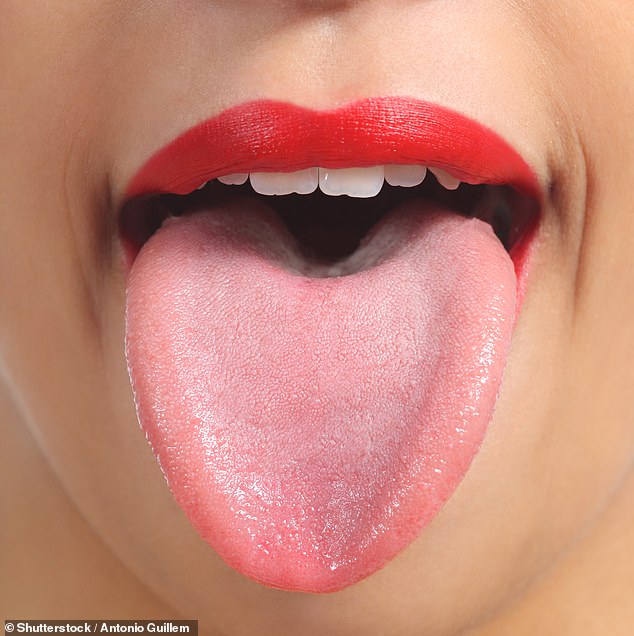Open wide! What the COLOUR of your tongue could be saying about your health
A dentist has warned that the color of your tongue can speak volumes about the state of your general health – and if you ignore it you could be risking your life.
Dentist Dr. Deepak Aulak says a healthy tongue should be pink, with small bumps – or papillae – across the surface.
However, a range of other colors can be a sign that someone is not feeling well.
Dr. Deepak, founder of AI-powered dental app Toothfairy, said: “Have you ever noticed your tongue in the mirror and thought, wait a minute, that’s not right?
‘The tongue is an incredible organ; without a tongue we would not be able to taste, chew and of course speak.
A healthy tongue should be pink, with small bumps – or papillae – across the surface. However, a range of other colors can be a sign that someone is not feeling well
‘But it’s much more than that, it’s an indicator, and any change can be a warning from your body that something else is going on with your health, and it’s time to see a doctor.
‘It can even be a matter of life and death, so it’s crucial that people know the warning signs their tongue is telling them.
‘Colors are always subjective, so contact a dentist for more information if you think something is wrong. ‘
In addition to healthy shades of pink, here are 10 colors your tongue could be, indicating that you may be deficient in certain nutrients or that you are sick.
White tongue
Patients with this condition have a thick, white coating on their tongue – this may be over the entire surface, at the back or in patches.
The condition results from overgrowth or swelling of the papillae, which can be caused by burning your tongue from especially hot food or drinks.
The ugly white mass is caused by bacteria and dead cells getting stuck between the inflamed papillae.
According to the NHSWhite tongue can also be a sign of anemia, scarlet fever, lichen planus, leukoplakia, canker sores and thrush.
Yellow or brown tongue
A yellow or brown tongue is usually an indicator of bacteria due to poor oral hygiene, smoking, drinking alcohol, coffee or black tea, per Mayo Clinic.

When dentist Dr. Deepak Aulak asks his patients to “open wide,” he’s looking for much more than just tooth decay and gum disease. He will also inspect the tongue.
Products containing thymol, menthol, witch hazel, peroxides and eucalyptus can also cause a yellow deposit on the tongue if the mouth is particularly dry.
Dehydration can lead to a yellow tongue, but also to psoriasis and jaundice.
If your face, eyes and tongue all appear yellow, it is advisable to speak to a GP as this could be a sign of liver or gallbladder problems (2).
Orange tongue
Like yellow tongue, poor oral health is usually the cause of orange tongue, although taking certain antibiotics or eating foods containing beta-carotene may be behind it.
Red tongue
A bright red tongue, often called “strawberry tongue,” can be a sign of a range of conditions ranging from vitamin deficiency to illness.
Geographic tongue is a condition that causes the tongue to appear red and develop map-like white spots on its surface.
WebMD says a bright red tongue can also be a sign of a food or drug allergy or a B vitamin deficiency.
Other conditions linked to red tongue include scarlet fever, erythroplakia – a possible precancerous condition – and glossitis, which causes your tongue to swell.
Strawberry tongue can also be a sign of Kawasaki disease in children under five years of age ChildrenHealth.
Gray tongue
Patients with geographic tongue may develop gray borders around the red spots on their tongue.
People with eczema are also known to develop gray tongues.
Another cause may be the use of antibiotics or antifungal medications, as well as certain antidepressants and iron supplements Royal Dental Care.
Black tongue
A black hairy tongue occurs when the papillae on the surface of the tongue also grow because they do not shed dead skin cells. This causes food and bacteria to become trapped, leading to the unpleasant discoloration.
Often the result of poor oral hygiene, smoking, chewing tobacco, taking certain medications and radiotherapy can also cause this.
Diabetes and HIV can also cause black tongue in rarer cases.

Dr. Deepak, This Morning regular and founder of AI-powered dental app Toothfairy, said: ‘Have you ever noticed your tongue in the mirror and thought: wait a minute, that’s not right? ‘The tongue is an incredible organ; without a tongue we would not be able to taste, chew and of course speak’
The conditions cause bad breath, a metallic taste in the mouth, and a stinging sensation in the mouth.
Purple tongue
Purple tongue can be an indicator of poor circulation, heart disease or Kawasaki disease, a rare condition that causes inflammation of the blood vessels in young children. MSD manual.
Green tongue
Similar to a yellow tongue, the appearance of a green tongue is the result of poor oral health, smoking, dry mouth or the use of certain medications.
Blue tongue
A blue tongue may be a sign that the person has cyanosis, where there is not enough oxygen in the blood.
The Cleveland Clinic says causes of cyanosis include blood disorders, vascular disease, insufficient oxygen from the lungs or kidney disease.
It can also be a sign of sepsis, which requires urgent medical attention.
The NHS recommends calling 999 if you or someone else has pale, blotchy or blue skin, lips or tongue.
